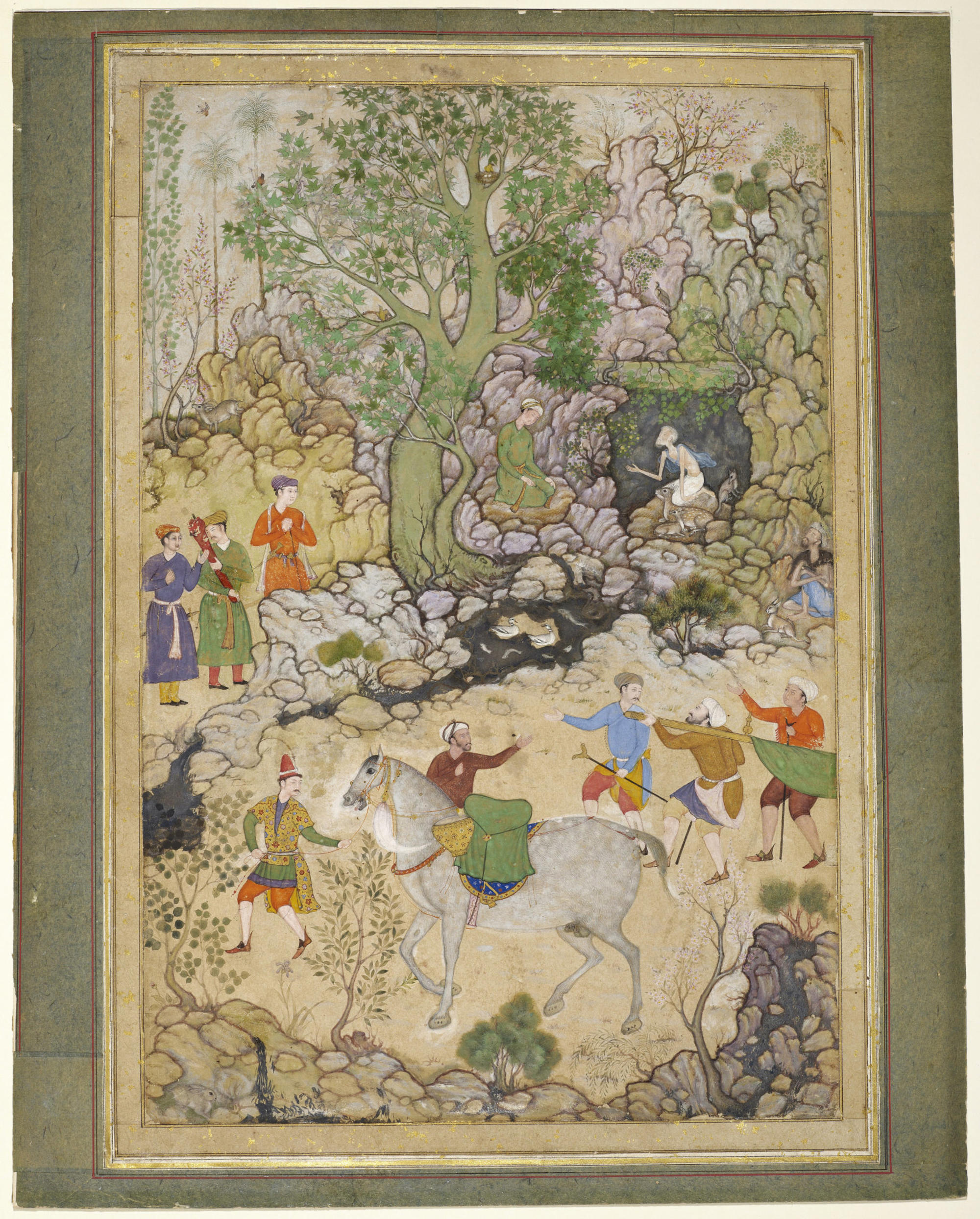Click on the image to zoom
A Prince and a Hermit
- Accession Number:AKM122
- Creator:Attributed to Abd al-Samad (Shirin Qalam)
- Place:Fatehpur Sikri, India
- Dimensions:39.6 x 31.3 cm
- Date:1580
- Materials and Technique:Opaque watercolour, silver, gold, paper
This colourful rocky landscape depicts a prince visiting a hermit at his cave. The prince is seated pensively before the hermit while his eight attendants wait on both sides of a small creek. His stately horse appears to be the focus of the painting, its grand and stocky figure occupying the major part of the lower half of the painting and emphasized by a natural halo formed by the sandy-coloured ground upon which it rests. As Anthony Welch has observed, the stallion was a symbol of authority and splendour but also one of “worldly impermanence” (Welch and Welch 1982, p. 160). Along with the brightly and colourfully dressed servants, the great horse stands in stark contrast to the hermit and his companion (perhaps a disciple), who sits before the cave at the water’s edge; their gaunt figures indicate their renouncement of worldly possessions in favour of following the path to enlightenment through mysticism. The top half of the painting evokes an air of meditation and sombreness that affects even the prince, who may have come here seeking the guidance of a spiritual advisor. The relationship between a Sufi master (shaykh, murshid, or pir) and his disciple (murid or shagird) was a popular theme in Persian poetry and painting. The master was charged with the task of leading his student along the challenging path (tariqa) towards enlightenment and the attainment of oneness with God. The transfer of knowledge between murid and murshid was seen as the transfer of light from the heart of the teacher to that of the student. The combination of a Persian painting style fused with the use of a more earth-toned palette and naturalistic rendering of figures and landscape, however, suggest that the present painting was produced in India under the reign of the Mughal emperor Akbar (r. 1556-1605 CE), a period marked by the synthesis of a diverse foreign and indigenous artistic styles. This combined aesthetic was a reflection of the ruler’s great tolerance for different religions; Akbar created the Din-i illahi (“Divine Faith”), which borrowed ideas from Islam, Christianity, Hinduism, Zoroastrianism, and Jainism (Canby 1998, p. 111). Welch has attributed the work on stylistic grounds to the Persian painter 'Abd al-Samad, an artist of the Safavid dynasty (1501-1732 CE) who left the court of Shah Tahmasp (r. 1524-76 CE) to work first for Akbar’s father, the emperor Humayun (r. 1530-39 CE and 1555-56 CE), and then for Akbar (Welch and Welch 1982, p. 160). Welch also believes that the prince represented in this image could be Akbar’s son Salim, the future emperor Jahangir (r. 1605-27 CE), based on the likeness of this figure to that of a seated prince in a tinted drawing identified as Prince Salim and signed by 'Abd al-Samad, also in the Museum's collection (ibid., p. 162; for an image of this work, see Canby 1998, p. 110, no. 80, although Canby identifies this figure as Akbar). Sheila Canby, however, has suggested that the princely figure may represent Akbar if it can be linked to a hunting event (qamargha) in the Punjab ordered by the emperor in April-May 1578 CE at the alleged site of one of Alexander the Great’s successful battles (Canby 1998, p. 111). According to Akbar’s historian Abu’l Fazl (d. 1602 CE), Akbar experienced an epiphany in the midst of the hunt, which led him to cancel the hunt and free all of the captured animals. Unaware of what had caused his change of heart, Akbar’s close friends imagined a few different theories, one of which involved the ruler’s meeting with an anchorite who inspired him to adopt a more ascetic lifestyle, something he did, in fact, do for a while after the incident (ibid., pp. 111 and 113).
References
Anthony Welch and Stuart Cary Welch, Arts of the Islamic Book: The Collection of Prince Sadruddin Aga Khan. London, 1982. ISBN: 9780801498824
Sheila R. Canby, Princes, Poets and Paladins: Islamic and Indian Paintings from the Collection of Prince and Princess Sadruddin Aga Khan. London, 1998. ISBN: 9780714114835
Note: This online resource is reviewed and updated on an ongoing basis. We are committed to improving this information and will revise and update knowledge about this object as it becomes available.


